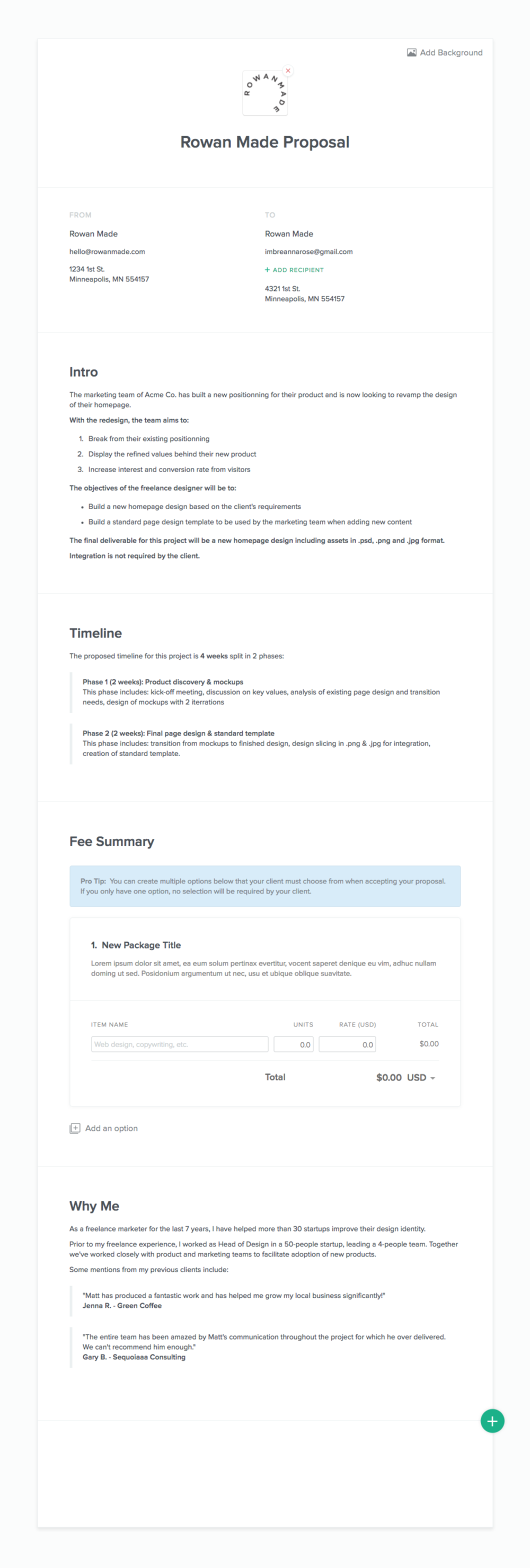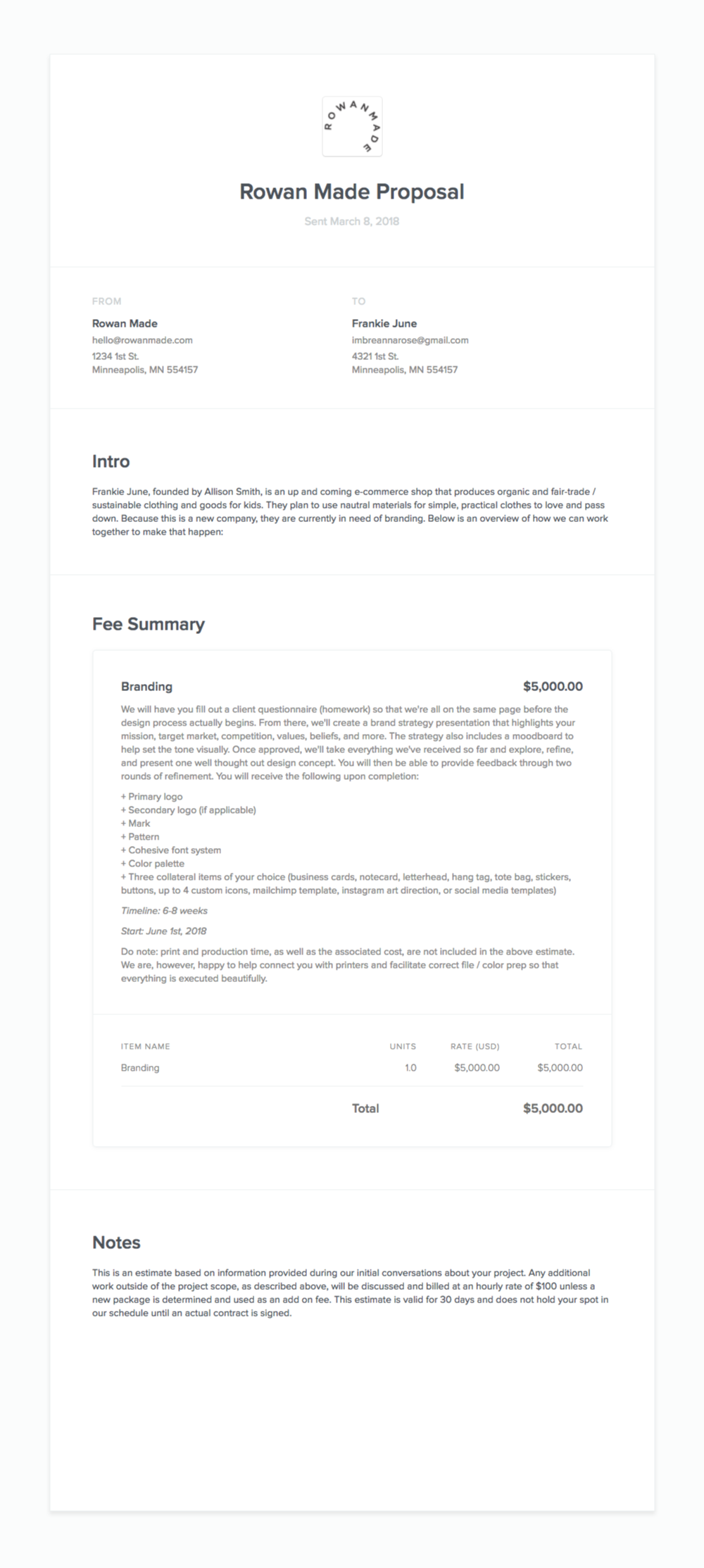Client Onboarding With Bonsai
Over a year ago, I wrote a post about bookkeeping and money management on the Rowan Made blog. And while some of what I shared is still relevant, my onboarding system (including proposals, invoicing, and contracts) has gone through a major overhaul. So! I thought I’d check in and update you all as to how we’re handling all of that now. Hint hint: we use Bonsai.
Now, rather than tell you exactly what Bonsai can do (because let’s face it ... that’s what their website is for), I’m going to walk you through how WE use it within our own process, starting with proposals.
* Quick note: Although I’ll be writing this post through the lens of a graphic designer, this process could absolutely apply to any creative field. In fact, Bonsai provides templates and direction for different backgrounds, so feel free to take a closer look at what they can provide for your specific situation.
PROPOSALS
Alright, so for example purposes, let’s say that we’ve already received an inquiry via email, spoken to them on the phone, and feel like it’s going to be a good fit for both parties. In that case, we typically put together a proposal so said inquiry knows exactly what their project would cost if they chose to officially move forward with us as their designer.
When you create a proposal with Bonsai, they first ask what kind of background you’re coming from (ie: design, development, writing, generic, etc.) so that they know what (editable) template to start you off with.
I always select “design,” which brings me to a template with the following sections: intro, timeline, fee summary, and why me (see image below). While these are nice, they are also FULLY editable, so you can change the titles, descriptions, and even delete anything you don’t need.
click to make larger
Personally, I don’t use all of the sections Bonsai provides out of the box, and instead create the following: intro, fee summary, and notes. In the intro section, I write a paragraph about our potential client as well as an overview of what they’re looking to achieve in working together. In the fee summary section, I put together a detailed list of what’s included. And in the notes section, I have a little write up about how long their proposal is valid.
Below you’ll find an image of what an actual proposal of ours looks like, but you can also view the same thing LIVE by clicking right here.
click to make larger
Whenever a proposal is ready to share, we simply send it over via email. You can do this through the Bonsai interface, or you can grab the proposal’s link and paste it directly into an email you craft on your own. I typically do the latter so that I can keep our conversation in one place.
CONTRACTS
Once a proposal is accepted, we begin the process of onboarding a new client into our system. Now, the (really) nice thing about Bonsai is that they provide contracts for you that are vetted by lawyers. I realize that in an ideal world, you’d be able to work with your own lawyer who can draft up something that’s unique to you, but that’s not always attainable.
So, if you end up using the contract that Bonsai provides, they’ll have you fill in a few details (client name, project cost, project details, etc.) and place them into their template for you. Then, all you have to do is digitally sign the contract and send it over to your client for them to digitally sign as well. Again, this can be done from the Bonsai interface or you can use the link they give you and paste it wherever you’d like.
* If you’re curious about what the Bonsai contract looks like, you can see one live right here.
I personally use the contract Bonsai provides as a base and have gone in and edited it to my own liking (with the help of my dad who is well versed in legalities). So whenever we start a new project, I'll use my own contract template, sign it, grab the link, and paste it into Asana since that’s where we handle project management (more on that here).
INVOICING
Our next step is to create a series of invoices for our client’s project. Bonsai does this automatically, based on the information we’ve given them to finalize the contract. So essentially, they’ll take the project cost, as well as the downpayment amount we’ve already set, and create invoices based on those numbers.
For example, let’s say that our client’s project cost is $5,000 and we require a 50% downpayment from them in order to hold their spot in our schedule. While creating their contract, all of that information will be recorded and Bonsai will then create two invoices, each being $2,500 (or 50%). But don’t worry. If you have alternative payment methods (recurring, split into thirds, etc.), you can define that to your liking as well.
Below you’ll find an image of what an actual invoice looks like. As you can see, everything is nicely outlined and there are payment options at the top of the page that clients can click on to pay. In our case, we allow PayPal or Bank Transfers, but bonsai also integrates with Stripe and Bitcoin.
click to make larger
When it comes time to send over an invoice, Bonsai will give you the option of doing it automatically (via scheduling) or manually. If you opt for automatic invoicing, everything would happen within the Bonsai interface without much effort on your part. But if you do things manually, you’ll also have the option of grabbing a link (much like before) so that you can paste it wherever you’d like. This is actually what we do, since we prefer to handle all communication within our project management system, Asana. This way our clients aren’t getting a ton of different emails from various platforms. ;)
- - - - - -
As of right now, we only use Bonsai for proposals, contracts, and invoicing. But they also provide time and expense tracking as well if that’s something you’ll need. So there you have it! The beginnings of how we onboard clients into our system here at Rowan Made. And hey, if you’re open to giving Bonsai a try, feel free to use our affiliate link for one month free. Although we’re affiliates of the platform, this is not a sponsored post. We’ve been using Bonsai for almost a year and genuinely love their service.




